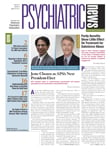The next phase in the study of deep brain stimulation (DBS) will need a rethinking of the way psychosurgical devices are used in research and treatment, said Joseph Fins, M.D., at the American Association for the Advancement of Science in Washington, D.C., in February. Fins is chief of the Division of Medical Ethics at Weill Cornell Medical College, where he also serves as a professor of medical ethics, medicine, and public health and a professor of medicine in psychiatry.
Present-day neurosurgery for psychiatric disorders, including DBS, is the direct, if distant, descendant of the bad old days of Egon Moniz and the prefrontal leucotomy in the 1930s, 1940s, and early 1950s. The advent of psychotropic drugs nearly eliminated that form of treatment.
Less-dramatic subcortical lesioning was also used to treat Parkinson's disease and tremor beginning in the 1940s, but ended with the advent of levadopa in the 1950s. However, as understanding of the organization of the basal ganglia grew, newer forms of psychosurgery were gradually reintroduced in the 1990s, along with stricter ethical controls on their use.
The 1979 Belmont Report on ethical principles and guidelines for the protection of human research subjects said that these surgical approaches should be used in humans only as a therapeutic, restorative, or palliative intervention and never for punishment or law-enforcement purposes.
In DBS, an electrode implanted in the brain is connected to a small device analogous to a cardiac pacemaker. Much of the research base for the technique was developed by neurologists for treating Parkinson's and other movement disorders, and recent research has expanded to cover psychiatric disorders such as depression and obsessive-compulsive disorder (OCD).
DBS was approved by the FDA in 2003 for neurological use to treat refractory Parkinson's disease and essential tremor, said Fins.
DBS Approved for Psychiatric Illness
Its use was extended into psychiatry when the FDA granted in 2009, by way of the humanitarian device exemption (HDE), permission to use DBS to treat OCD that is unresponsive to medication or psychotherapy.
An HDE may be granted if there are fewer than 4,000 cases a year, presumably a population too small to permit an adequately powered clinical trial, said Fins. A device manufacturer must demonstrate only safety, but not effectiveness, in clinical trials for this use, he said.
The exemption opens marketing opportunities for manufacturers even as it raises regulatory questions for Fins. OCD is hardly an orphan disease, he noted. An estimated 2.2 million people in this country have the disorder, and perhaps 500,000 people have the chronic, severe, treatment-resistant form, which qualifies them for a clinical trial of DBS.
Using the HDE rather than going through a clinical trial only confuses research and therapy, Fins suggested. The FDA contributes to the confusion by demanding an institutional review board review, as in a clinical trial, but not a research-related informed consent from the patient, implying that the treatment is a form of therapy. The FDA sees this use of DBS to treat OCD as the "practice of medicine."
"So DBS is marketed as therapy even before it's proven as therapy," said Fins. Patients don't really know if the treatment they receive is likely to benefit them because the accepted standards of proof are still absent, he said.
Reimbursement Problems Cited
The failure to demonstrate efficacy has reimbursement problems, too, since insurance companies will pay only for treatment that is proven effective as well as safe.
In addition, DBS research relies excessively on industry for devices and funds because investigators can't make their own devices or freely obtain them, he said. Thus they are dependent on industry good will and funds for their work. He noted that the need to maximize the likelihood of successful outcomes for marketing purposes could lead to the perception of conflicts of interest.
"Much of this is basic science, anyway," said Fins, and should be funded more by the National Institutes of Health than by industry.
Furthermore, researchers miss the opportunity for real scientific discovery because the use of DBS is not conducted as a controlled trial.
To overcome these drawbacks, Fins would seek revision of the Bayh-Dole Act, which encourages commercialization of new drugs and devices. Currently, the law provides a near monopoly for manufacturers, who can choose not to share rights or access to devices for research.
He recommends modifying the law to create a federal clearinghouse for devices from which investigators could draw for Phase I research purposes without gaining intellectual-property rights. Manufacturers would be protected from liability at this stage by legislation similar to that shielding vaccine producers.
This arrangement could lead to more funding for basic research, while allowing industry to pick the best candidates for commercialization in Phase 2 rather than in the earlier and riskier Phase 1 of the clinical trial sequence. A clearinghouse system would also ease the establishment of registries and help standardize ethical review, he said.
Finally, patients and payers would have greater trust in the use of DBS because the underlying research base would be sounder, Fins maintained.
Properly conducted research might have another value as well, said Helen Mayberg, M.D., a professor of psychiatry and behavioral sciences and neurology at Emory University, who spoke on the same panel at the meeting. Mayberg studies the use of DBS in depression.
Electrical investigation of different brain areas using DBS might pinpoint new targets for pharmaceutical researchers, said Mayberg.
"So the next step won't be more surgery but more new drugs," she said. "Research could explain more about the illness and not just about the treatment."
